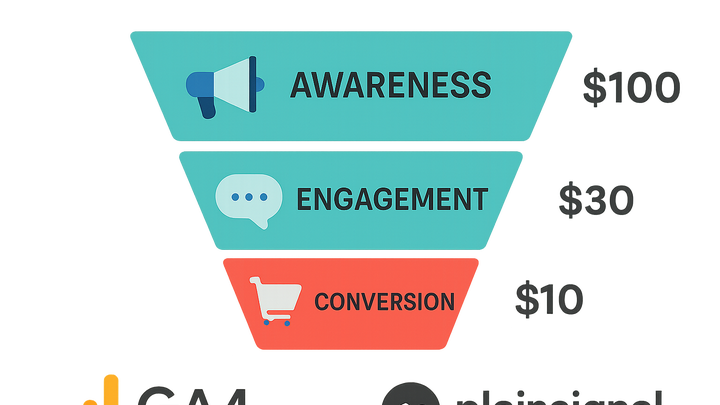Published on 2025-06-28T04:24:54Z
What is Conversion Value? Examples and Applications
Conversion Value is a metric used in analytics to quantify the monetary or assigned value of user actions that are considered valuable to a business. It can represent direct revenue from ecommerce purchases or subjective values like sign-ups, downloads, or form submissions.
By assigning a dollar amount (or other business units) to conversions, teams can calculate ROI, compare performance across channels, and optimize marketing spend based on value delivered rather than just volume. Conversion Value turns abstract events into concrete numbers, enabling more strategic decision-making. Modern analytics platforms like Google Analytics 4 (GA4) and PlainSignal support both static and dynamic value tracking, whether through event parameters or automatic ecommerce measurements.
Understanding how to configure, capture, and interpret Conversion Value is essential for marketing, product, and analytics teams aiming for data-driven growth.
Conversion value
Quantifies the monetary worth of user conversions, enabling ROI calculation and optimized marketing spend.
Why Conversion Value Matters
Conversion Value translates user actions into monetary or business-defined metrics, making it possible to evaluate campaign effectiveness and allocate resources wisely. Without assigning value, teams have no common currency to compare diverse conversion types such as purchases, sign-ups, and downloads. By focusing on value rather than raw counts, organizations can optimize toward high-impact outcomes and better forecast revenue. Conversion Value also powers advanced attribution models, helping surface the true drivers of growth.
-
Measuring marketing roi
By linking conversion actions to dollars (or other units), you can calculate ROI for individual campaigns, channels, or keywords. This reveals which initiatives drive the most profit relative to cost.
-
Campaign performance
Evaluate each marketing campaign by comparing the total conversion value generated against the ad spend.
-
Lifetime value
Use Conversion Value to estimate the long-term revenue generated by a cohort of users.
-
-
Optimizing budget allocation
Allocation decisions are more effective when based on value per acquisition rather than volume. You can shift spend toward high-value conversions.
-
Channel efficiency
Identify and prioritize channels that deliver the highest conversion value per dollar spent.
-
Bid strategy optimization
Set bids in programmatic and search campaigns based on the expected conversion value.
-
How Conversion Value is Calculated
Conversion Value can be derived in two main ways: static assignment or dynamic tracking. Static values are pre-defined by marketers to represent goals like newsletter sign-ups or lead generation, while dynamic values capture real transaction amounts. The choice depends on business needs, event types, and available data sources.
-
Manual value assignment
Marketers define a fixed value for non-transactional conversions, such as \(10 for a newsletter subscription or \)50 for a demo request. This simplifies reporting when exact revenue data is unavailable.
-
Define goals
List all key conversion events and determine their relative importance to the business.
-
Assign monetary values
Allocate a dollar amount to each event based on average revenue per lead or strategic priority.
-
-
Dynamic revenue tracking
Automatically capture actual transaction values from ecommerce platforms or in-app purchases, ensuring precise revenue measurement.
-
Ecommerce tracking
Send the purchase amount and currency via analytics events during checkout.
-
In-app purchase values
Integrate SDKs or event parameters to report purchase values from mobile or desktop apps.
-
Tracking Conversion Value in Google Analytics 4
GA4 uses an event-based model, where you can designate any event as a conversion and pass a numeric
value parameter. This flexibility allows both static and dynamic value tracking within a
unified interface.
-
Setup in GA4
Enable Enhanced Ecommerce for ecommerce sites or configure custom events for other actions. Mark events as conversions and include the
valueandcurrencyparameters.-
Enable enhanced ecommerce
In GA4 Admin settings, activate monetization features under Data Streams.
-
Configure events with `value`
Use gtag.js or Google Tag Manager to send events like
purchasewith parameters:value,currency, anditems.
-
-
Analysis and reporting
Use the Realtime, Reports, and Explorations sections to analyze conversion value across dimensions such as source/medium, user demographics, and device type.
-
Monetization reports
View revenue and purchase data under the Monetization section.
-
Custom explorations
Build tailored funnel and cohort reports to dive deeper into value metrics.
-
Tracking Conversion Value with PlainSignal
PlainSignal offers cookie-free analytics and supports custom event tracking, including conversion values. It’s ideal for privacy-focused sites that still need to measure value-driven outcomes.
-
Integrating PlainSignal
Add the PlainSignal script to your pages, then send custom events with a
valueparameter using the API or data attributes.-
Embed tracking script
Insert the following code snippet into your site’s
<head>section:<link rel="preconnect" href="//eu.plainsignal.com/" crossorigin /> <script defer data-do="yourwebsitedomain.com" data-id="0GQV1xmtzQQ" data-api="//eu.plainsignal.com" src="//cdn.plainsignal.com/plainsignal-min.js"></script> -
Send conversion events
Use the PlainSignal API to send events with values, for example:
PlainSignal('track', 'purchase', { value: 29.99 });
-
-
Retrieving value data
Access conversion value metrics in the PlainSignal dashboard or via the reporting API for deeper analysis.
-
Dashboard reports
View total and average conversion values in the custom events section of the dashboard.
-
Api data export
Pull raw event data with associated values using the PlainSignal reporting API.
-
